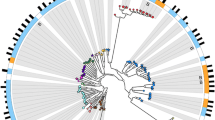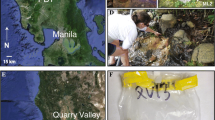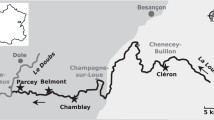Abstract
Spatial and temporal distribution and characteristics of three eukaryotic biofilms were monitored for an 18-month period in an acid mine drainage environment at the Green Valley coalmine in Indiana, USA. Each biofilm is dominated (>90 %) by a single eukaryotic microorganism based on enumeration: Euglena mutabilis, the diatom species Nitzschia tubicola, and a filamentous alga belonging to the genus Klebsormidium sp. The E. mutabilis-dominated biofilm occurs year round, covering up to 100 % of the channel bottom in spring and fall. The N. tubicola-dominated biofilm is less abundant, exists as small patches in spring and fall, expands from these patches to cover up to 50 % of the channel bottom in June, and is absent in winter. The Klebsormidium-dominated biofilm is restricted to small patches covering <5 % of the channel bottom from spring through fall and is absent in winter. Also present are floating microbial scum layers. The eukaryotic biofilms and scum layers contribute to the attenuation of precipitates and to the formation of organosedimentary structures, or stromatolites, by trapping and binding chemical precipitates via aerotaxis and phototaxis and by serving as a medium for passive accumulation of precipitates. Each stromatolite layer represents the morphological characteristics of each eukaryotic biofilm that served as the architect of the layer and the time of year the biofilm populated the channel. Processes involved in stromatolite formation also attenuate chemical sediments by binding them to the channel bottom and prior stromatolite surface rather than allowing them to be carried to the adjacent drainage system where they may become bioavailable to other forms of life.










Similar content being viewed by others
References
Aguilera A, Souza-Egipsy V, Gómez F, Amils R (2007a) Development and structure of eukaryotic biofilms in an extreme acidic environment, Río Tinto (SW, Spain). Microb Ecol 53:294–305
Aguilera A, Zettler E, Gómez F, Amaral-Zettler L, Rodríguez N, Amils R (2007b) Distribution and seasonal variability in the benthic eukaryotic community of Río Tinto (SW, Spain), an acidic, high metal extreme environment. Syst Appl Microbiol 30:531–546
Awramik SM, Margulis L, Barghoorn ES (1976) Evolutionary processes in the formation of stromatolites. In: Walter MR (ed) Stromatolites. Elsevier, New York, pp 149–162
Banfield JF, Welch SA, Zhang H, Ebert TT, Penn RL (2000) Aggregation-based crystal growth and microstructure development in natural iron oxyhydroxide biomineralization products. Science 289:751–754
Bauld J, D’Amelio E, Farmer JD (1992) Modern microbial mats. In: Schopf J, Klein C (eds) The Proterozoic biosphere. Cambridge University Press, New York, pp 261–269
Beveridge TJ (1989) Role of cellular design in bacterial metal accumulation and mineralization. Ann Rev Microbiol 43:147–171
Bigham JM, Nordstrom DK (2000) Iron and aluminum hydroxysulfates from acid sulfate water. In: Alpers CN, Jambor JL, Nordstrom DE (eds) Sulfate minerals-crystallography, geochemistry, and environmental significance, vol 40., Review in mineralogy and geochemistry. Mineralogical Society of America, Washington, DC, pp 351–403
Bigham JM, Schwertmann U, Carlson L, Muard E (1990) A poorly crystallized oxyhydroxysulfate of iron formed by bacterial oxidation of Fe(II) in acid mine waters. Geochim Cosmochim Acta 54:2743–2758
Bosak T, Greene SE, Newman DK (2007) A likely role for anoxygenic photosynthetic microbes in the formation of ancient stromatolites. Geobiology 5:119–126
Boult S, Johnson M, Curtis C (1997) Recognition of a biofilm at the sediment-water interface of an acid mine drainage-contaminated stream, and its role in controlling iron flux. Hydrol Process 11:391–399
Brake SS, Hasiotis ST (2010) Eukaryote-dominated biofilms and their significance in acidic environments. Geomicrobiol J 27:534–558
Brake SS, Dannelly HK, Jones M, Lawson LA (1999) Acid mine drainage at the Green Valley Mine, Vigo County, Indiana: possible influence of an acidophilic alga. In: Oliver J, Dutta P (eds) Indiana Studies. Indiana State University Prof. Paper, vol 21, pp 45–52
Brake SS, Connors KA, Romberger SB (2001) A river runs through it: impact of acid mine drainage on the geochemistry of West Little Sugar Creek pre- and post-reclamation at the Green Valley coal mine, Indiana, USA. Environ Geol 40:1471–1481
Brake SS, Hasiotis ST, Dannelly HK, Connors KA (2002) Eukaryotic stromatolite builders in acid mine drainage: implications for Precambrian iron formations and oxygenation of the atmosphere? Geology 30:599–602
Brierley JA, Brierley CL (1999) Present and future commercial applications of biohydrometallurgy. In: Amils R, Ballester A (eds) Biohydrometallurgy and the environment toward the mining of the 21st century, Part A. Elsevier, Amsterdam, pp 81–89
Brierley CL, Brierley JA, Davidson MS (1989) Applied microbial processes for metal recovery and removal from wastewater. In: Beveridge TJ, Doyle RJ (eds) Metal ions and bacteria. Wiley, New York, pp 359–381
Bruneel O, Duran R, Casiot C, Elbaz-Poulichet F, Personne J-C (2006) Diversity of microorganisms in Fe–As-rich acid mine drainage waters of Caroulès, France. Appl Environ Microb 72:551–556
Butcher RW (1946) The algal growth in certain highly calcareous streams. J Ecol 28:283–286
Cohn SA, Weitzell RE (1996) Ecological considerations of diatom cell motility. I. Characterization of motility and adhesion in four diatom species. J Phycol 30:928–939
Colmer AR, Temple KL, Hinkle HE (1950) Anion-oxidizing bacterium from the acid drainage of some bituminous coal mines. J Bacteriol 59:317–328
Costerton JW, Marrie TJ, Cheng K-J (1985) Phenomena of bacterial adhesion. In: Savage DC, Fletcher M (eds) Bacterial adhesion: mechanisms and physiological significance. Plenum Press, New York, pp 3–43
Coupland K, Johnson DB (2004) Geochemistry and microbiology of an impounded subterranean acidic water body at Mynydd Parys, Anglesey, Wales. Geobiology 2:77–86
Dach HV (1943) The effect of pH on pure cultures of Euglena mutabilis. Ohio J Sci 43:47–48
Daniel GF, Chamberlain AHL, Jones EBG (1987) Cytochemical and electron microscopical observations on the adhesive materials of marine fouling diatoms. Br Phycol J 22:101–118
Decho AW (1994) Molecular-scale events influencing the macroscale cohesiveness of exopolymers. In: Krumbein WE, Paterson DM, Stal LJ (eds) Biostabilization of sediments. University of Oldenburg, Oldenburg, pp 135–148
Decho AW (2000) Exopolymer microdomains as a structuring agent for heterogeneity within microbial biofilms. In: Riding RE, Awramik SM (eds) Microbial sediments. Springer, Heidelberg, pp 9–15
Decho AW, Castenholtz RW (1986) Spatial patterns and feeding of meiobenthic harpacticoid copepods in relation to resident microbial flora. Hydrobiologia 131:87–96
Dodd JJ (1987) The illustrated flora of Illinois. Southern Illinois University Press, Carbondale
Drever JI (1997) The geochemistry of natural waters, 3rd edn. Prentice Hall, Upper Saddle River
Druschel GK, Baker BJ, Gihring TM, Banfield JF (2004) Acid mine drainage biogeochemistry at Iron Mountain, California. Geochem Trans 5:13–32
Dzombak DA, Morel FMM (1990) Surface complexation modeling-hydrous ferric oxide. John Wiley and Sons, Somerset
Edwards KJ, Bond PL, Gihring TM, Banfield JF (2000) An Archeal iron-oxidizing extreme acidophile important in acid mine drainage. Science 287:1796–1799
Epply RW (1977) The growth and culture of diatoms. In: Werner D (ed) The biology of diatoms, botanical monographs, vol 13. University of California Press, Berkeley, pp 24–64
Ferris FG, Tazaki L, Fyfe WS (1989) Iron oxides in acid mine drainage environments and their association with bacteria. Chem Geol 74:321–330
Fitch FJ (1959) Macro point counting. Am Mineral 44:667–668
Foster JS, Green SJ (2011) Microbial diversity in modern stromatolites. In: Tewari VC, Seckback J (eds) Stromatolites: interaction of microbes with sediment. Cellular origin, life in extreme habitats, and astrobiology, vol 18, pp 383–405
Fowler TA, Crundwell FK (1999) Leaching of zinc sulfide by Thiobacillus ferrooxidans: bacterial oxidation of the sulfur product layer increases the rate of zinc sulfide dissolution at high concentrations of ferrous ions. Appl Environ Microb 65:5285–5292
Gadd GM (1990) Metal tolerance. In: Edwards C (ed) Microbiology of extreme environments. McGraw-Hill, New York, pp 178–209
Golubic S (1976) Organisms that build stromatolites. In: Walter MR (ed) Stromatolites. Elsevier, New York, pp 113–126
Golubic S, Seong-Joo L, Browne KM (2000) Cyanobacteria: architects of sedimentary structures. In: Riding RE, Awramik SM (eds) Microbial sediments. Springer, Berlin, pp 57–67
Häder D-P, Hoiczyk E (1992) Gliding motility. In: Melkonian M (ed) Algal cell motility. Chapman and Hall, New York, pp 1–38
Häder D-P, Melkonian M (1983) Phototaxis in the gliding flagellate, Euglena mutabilis. Arch Microbiol 135:25–29
Hallberg KB, Johnson DB (2003) Novel acidophiles isolated from moderately acidic mine drainage waters. Hydrometallurgy 71:139–148
Hallmann R, Friedrich A, Koops H-P, Pommerening-Röser A, Rohde K, Zenneck C, Sand W (1993) Physiological characteristics of Thiobacillus ferrooxidans and Leptospirillum ferrooxidans and physiochemical factors influence microbial metal leaching. Geomicrobiol J 10:193–206
Hargreaves JW, Lloyd EJH, Whitton BA (1975) Chemistry and vegetation of highly acidic streams. Freshw Biol 5:563–576
Harper MA (1977) Movements. In: Werner D (ed) The biology of diatoms, vol 13, Botanical monograph. University of California Press, Berkley, pp 224–249
Hoagland KD, Rosowski JR, Gretz MR, Roemer SC (1993) Diatom extracellular polymeric substances: function, fine structure, chemistry, and physiology. J Phycol 29:537–566
Hynes HBM (1970) The ecology of running waters. University of Toronto Press, Toronto
Jackson ED, Ross DC (1956) A technique for modal analysis of medium- and course-grained (3-10 mm) rocks. Am Mineral 41:648–651
Johnson DB (1998) Biodiversity and ecology of acidophilic microorganisms. FEMS Microbiol Ecol 27:307–317
Jones JRE (1951) An ecological study of the River Towy. J Anim Ecol 20:68–86
Kai T, Suenaga Y, Migita A, Takahashi T (2000) Kinetic model for simultaneous leaching of zinc sulfide and manganese dioxide in the presence of iron-oxidizing bacteria. Chem Eng Sci 55:3429–3436
Kelly MG, Bennison H, Cox EJ, Goldsmith B, Jamieson J, Juggins S, Mann DG, Telford RJ (2005) Common freshwater diatoms of Britain and Ireland: an interactive key. Environment Agency, Bristol. http://craticula.ncl.ac.uk/EADiatomKey/html/taxon13541440.html. Accessed 12 August 2011
Kim JJ, Kim SJ, Tasaki K (2002) Mineralogical characterization of microbial ferrihydrite and schwertmannite, and non-biogenic Al-sulfate precipitates from acid mine drainage in the Donghae mine area, Korea. Environ Geol 42:19–31
Kleinmann RLP, Crerar DA (1979) Thiobacillus ferrooxidans and the formation of acidity in simulated coal mine environments. Geomicrobiol J 1:373–388
Krumbein WE (1986) Biotransfer of minerals by microbes and microbial mats. In: Leadbeater BSC, Riding R (eds) Biomineralization in lower plants and animals. Clarendon Press, Oxford, pp 55–72
Krumbein WE (1994) The year of the slime. In: Krumbein WE, Paterson DM, Stal LJ (eds) Biostabilization of sediments. University of Oldenburg, Oldenburg, pp 1–7
Kwandrans J (1993) Diatom communities of acidic mountain streams in Poland. Hydrobiologia 269(270):335–342
Lackey JB (1938) The flora and fauna of surface waters polluted by acid mine drainage. Public Health Rep 53:1499–1507
Lackey JB (1968) The biology of Euglena. I: general biology and ultrastructure. In: Buetow DE (ed) Ecology of Euglena. Academic Press, New York, pp 27–44
Lazaroff N, Sigal W, Wasserman A (1982) Iron oxidation and precipitation of ferric hydrosulfates by resting Thiobacillus ferrooxidans cells. Appl Environ Microb 43:924–938
Lee JJ, Leedale GF, Bradbury P (2000) The illustrated guide to the protozoa, 2nd edn. Society of Protozoologist, Lawrence
Lepot K, Benzerara K, Brown GE Jr, Philppot P (2008) Microbially influenced formation of 2,724-million-year-old stromatolites. Nat Geosci 1:118–121
López-Archilla AI, Marin I, Amils R (2001) Microbial community composition and ecology of an acidic aquatic environment: the Tinto River, Spain. Microb Ecol 41:20–35
Margulis L, Corliss JO, Melkonian M, Chapman DJ (1990) Handbook of protoctista. Jones and Bartlett Publishers, Boston
Marina A, Marini L, Ottonello G, Zuccolini MV (2005) The fate of major constituents and chromium and other trace elements when acid waters from the derelict Libiola mine (Italy) are mixed with stream waters. Appl Geochem 20:1368–1390
McBride TP (1988) Preparing random distributions of diatom valves on microscopic slides. Limnol Oceanogr 33:1627–1629
Melkonian M, Meinicke-Liebelt M, Häder D-P (1986) Photokinesis and photophobic responses in the gliding flagellate, Euglena mutabilis. Plant Cell Physiol 27:505–513
Minckley WL, Tindall DR (1963) Ecology of Batrachospermum sp. (Rhodophyta) in Doe Run, Meade County, Kentucky. Bull Torrey Bot Club 90:391–400
Moses CO, Nordstrom DK, Herman JS, Mills AL (1987) Aqueous pyrite oxidation by dissolved-oxygen and by ferric iron. Geochim Cosmochim Ac 51:1561–1571
Murayama T, Konno Y, Sakata T, Imaizumi T (1987) Application of immobilized Thiobacillus ferrooxidans for large-scale treatment of acid mine drainage. In: Mosbach K (ed) Methods in enzymology, vol 136. Academic Press, New York, pp 530–540
Papineau D, Walker JJ, Mojzsis SJ, Pace NR (2005) Composition and structure of microbial communities from stromatolites of Hamelin Pool in Shark Bay, Western Australia. Appl Environ Microb 71:4822–4832
Patrick R, Reimer CW (1966) The diatoms of the United States, vol 13, 1st edn., Monograph Series. Academy of Natural Sciences, Philadelphia
Pogliani C, Donati E (2000) Enhancement of copper dissolution from a sulfide ore by using Thiobacillus thiooxidans. Geomicrob J 17:35–42
Porter KG (1976) Enhancement of algal growth and productivity by grazing zooplankton. Science 192:1332–1334
PROTIST INFORMATION SERVER (2011) A digital specimen archive database, copyright 1995–2011. http://protist.i.hosei.ac.jp. Accessed November 2011
Round FE, Crawford RM, Mann DG (1990) The diatoms. Biology and morphology of the genera. Cambridge University Press, Cambridge
Ruttner R (1926) Bermerkungen über den Sauerstoffgehalt der Gewässer und dessen respiratorischen Wert. Naturwissenschaften 14:1237–1239
Sand W, Gerke T, Hallmann R, Schippers A (1995) Sulfur chemistry, biofilm, and the (in)direct attack mechanism—a critical evaluation of bacterial leaching. Appl Microbiol Biotechnol 43:961–966
Schopf JW, Kudryavtsev AB, Czaja AD, Tripathi AB (2007) Evidence of Archean life: stromatolites and microfossils. Precambrian Res 158:141–155
Sen AM, Johnson B (1999) Acidophilic sulphate-reducing bacteria: candidates for bioremediation of acid mine drainage. In: Amils R, Ballester A (eds) Biohydrometallurgy and the environment toward the mining of the 21st century, Part A. Elsevier, Amsterdam, pp 709–718
Sharp RJ, Munster MJ (1986) Biotechnological implications for microorganisms from extreme environments. In: Herbert RA, Cobb GA (eds) Microbes in extreme environments. Academic Press, London, pp 215–295
Smith KS (1999) Metal sorption on mineral surfaces-an overview with examples relating to mineral deposits. In: Plumlee GS, Logdon MJ (eds) The environmental geochemistry of mineral deposits, part A-processes, techniques, and health issues, vol 6A., Reviews in economic geology. Society of Economic Geologists, Littleton, pp 161–182
Smithson SB (1963) A point-counter for modal analysis of stained rock slabs. Am Mineral 48:1164–1166
Suzuki I, Takeuchi TL, Yuthasastrakosol TD, Oh JD (1990) Ferrous iron and sulfur oxidation and ferric iron reduction activities of Thiobacillus ferrooxidans are affected by growth on ferrous iron, sulfur, or a sulfide ore. Appl Environ Microb 56:1620–1626
Swift MC (1982) Effects of coal pile runoff on stream quality and macro-invertebrate communities, vol 68., Water Resources Research Center Technical Report. University of Maryland, College Park
Torma AE (1986) Biohydrometallurgy as an emerging technology. Biotechnol Bioeng Symp 16:49–63
Valente TM, Gomes CL (2007) The role of two acidophilic algae as ecological indicators of acid mine drainage sites. J Iber Geol 22:283–294
Walter MR, Bauld J, Des Marais DJ, Schopf JW (1992) A general comparison of microbial mats and microbial stromatolites: bridging the gap between the modern and the fossil. In: Schopf JW, Klein C (eds) The proterozoic biosphere. Cambridge University Press, Cambridge, pp 335–338
Werner D (1977) The biology of diatoms: botanical monograph, vol 13. University of California Press, Berkeley
Westall F, Walsh MM, Toporski J, Steele A (2003) Fossil biofilms and the search for life on Mars. In: Krumbein WE, Paterson DM, Zavarzin GA (eds) Fossil and recent biofilms. Kluwer Academic Publishers, Dordrecht, pp 447–465
Whitford LA (1960) The current effect and growth of fresh-water algae. Trans Am Microsc Soc 79:302–309
Whitford LA, Schumacher GJ (1961) Effect of current on mineral uptake and respiration by a fresh-water alga. Limnol Oceanogr 6:423–425
Whitford LA, Schumacher GJ (1964) Effect of a current on respiration and mineral uptake in Spirogyra and Oedogonium. Ecology 45:168–170
Winsborough BM (2000) Diatoms and benthic microbial carbonates. In: Riding RE, Awramik SM (eds) Microbial sediments. Spring, Berlin, pp 76–83
Wood TA, Murray KR, Burgess JG (2001) Ferrous sulphate oxidation using Thiobacillus ferrooxidans cells immobilized on sand for the purpose of treating acid mine-drainage. Appl Microbiol Biotechnol 56:560–565
Zimmerman P (1961) Experimentelle untersuchungen über den einfluss der strömungsgeschwindigkeit auf die fliesswasserbiozönose. Internat Verein Limnol 14:396–399
Acknowledgments
The microbial distribution aspect of this research was part of a Master’s thesis conducted by I. Arango (IA) for the Department of Geography, Geology, and Anthropology at Indiana State University, Terra Haute. IA thanks the Geological Society of America for graduate student research grant. We thank Diana Winter for confirming our taxonomic assessment of the diatoms at Green Valley. We thank the Indiana State University Climatology Laboratory for supplying rainfall data. We thank anonymous reviewers for their helpful comments and suggestions on the original manuscript.
Author information
Authors and Affiliations
Corresponding author
Rights and permissions
About this article
Cite this article
Brake, S.S., Arango, I., Hasiotis, S.T. et al. Spatial and temporal distribution and characteristics of eukaryote-dominated microbial biofilms in an acid mine drainage environment: implications for development of iron-rich stromatolites. Environ Earth Sci 72, 2779–2796 (2014). https://doi.org/10.1007/s12665-014-3185-x
Received:
Accepted:
Published:
Issue Date:
DOI: https://doi.org/10.1007/s12665-014-3185-x




